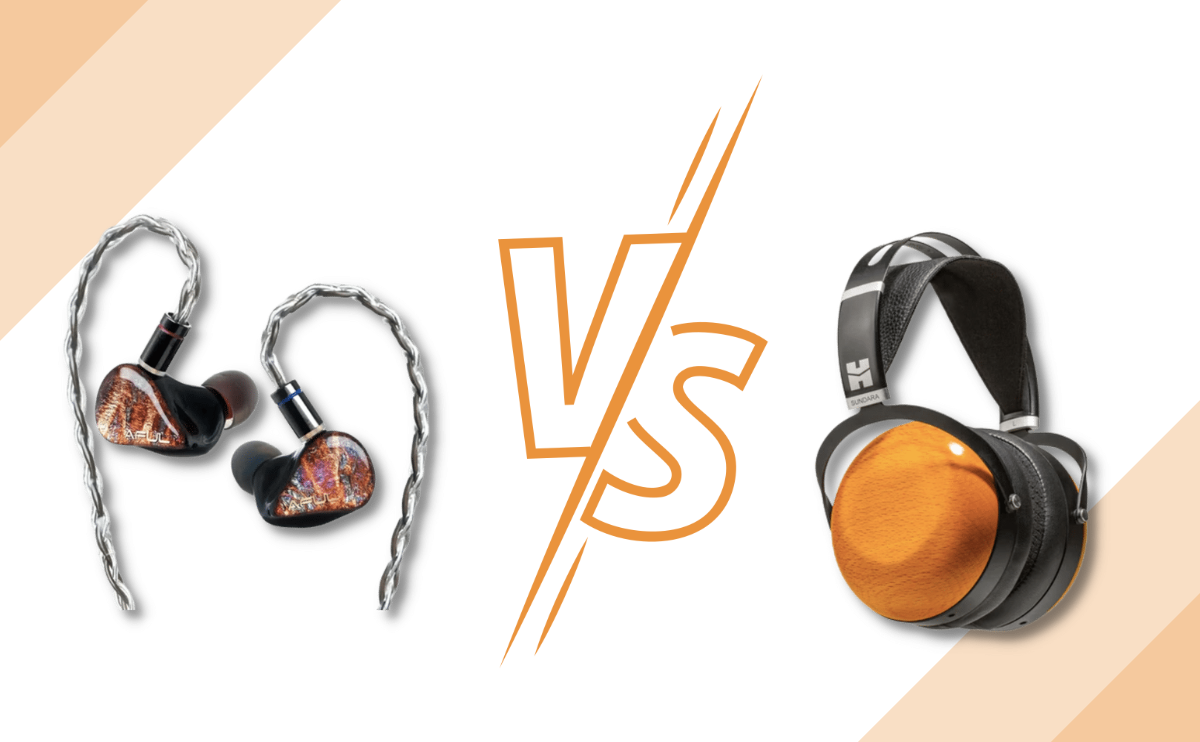Are you torn between Studio Headphones Vs In-Ear Monitors and struggling to decide which option is best for your needs? Understanding the differences between Studio Headphones and In-Ear Monitors is essential to make an informed decision.
Studio Headphones and In-Ear Monitors offer unique benefits that cater to different preferences and usage scenarios.
Studio headphones, typically circumaural, are designed for mixing, mastering, and critical listening; they’re prized for their depth of sound and wide soundstage.
On the other hand, In-ear monitors are discreet, fit snugly in the ear canal, and offer excellent noise isolation—perfect for stage performances and on-the-go listening.
To determine the best choice, consumers should evaluate factors such as sound fidelity, comfort during extended use, and the specific scenarios in which the headphones will be used.
Let’s delve deeper into the characteristics and features of Studio Headphones Vs In-Ear Monitors to help you choose the right audio gear for your specific requirements.
Decoding The Essentials: Studio Headphones
Studio headphones are a crucial tool for sound professionals. They differ from standard headphones in several key ways. These differences impact the sound quality, comfort, and overall listening experience.
Understanding these essentials helps an informed choice for studio work or audio perfection.
Acoustic Structure And Sound Isolation
The acoustic structure of studio headphones is designed with precision. It ensures accurate sound reproduction. Sound isolation is also pivotal for studio headphones. It blocks outside noise, offering a clean listening environment.
This isolation enables producers and engineers to focus on the minutest details.
- Closed-back designs offer excellent sound isolation.
- Open-back designs provide a more natural sound experience but less isolation.
Comfort And Durability For Extended Wear
Comfort becomes non-negotiable with long studio sessions. Studio headphones offer cushioned ear pads and adaptable headbands. Durability is equally important. Robust materials give studio headphones a longer life.
| Feature | Benefit |
|---|---|
| Padded ear cups | Less ear fatigue |
| Adjustable headbands | Fit various head sizes |
| Quality materials | Withstand wear and tear |
Frequency Response And Sound Accuracy
The frequency response in studio headphones is designed to be flat. This feature ensures sound accuracy. It reproduces sound faithfully, without altering or suppressing any frequencies. This accuracy is critical for mixing and mastering.
- Low frequencies are the bass sounds.
- Mid frequencies are the vocal ranges.
- High frequencies cover treble sounds.
The flat response allows for precise adjustments when producing music.

Credit: www.theaudiostore.in
In-ear Monitors Unveiled
Welcome to the world where precision audio meets the ease of use. In-Ear Monitors (IEMs) shine on stage and in the studio. They provide superb sound quality for musicians and audio professionals. IEMs stand apart from traditional studio headphones.
With a focus on design, noise isolation, and customization, IEMs offer a unique listening experience. Let’s dive into the features that make these sleek devices a preferred choice for performers everywhere.
Design And Portability For On-stage Use
On-stage, freedom of movement is key. In-Ear Monitors boast a compact design. They slip right into your ear canal. This means no bulky headphones slipping off while rocking out. IEMs fit securely, making them ideal for active performers. Look at these benefits:
- Lightweight and inconspicuous: Wear them for hours without discomfort.
- Cable design: Often featuring behind-the-ear cable routing to stay out of the way.
- Portability: Carry them in a small case – perfect for touring.
Noise Isolation For Focused Monitoring
Ambient noise can distract. With In-Ear Monitors, clarity is front and center. They seal your ears from outside noise. This creates a focused space for monitoring your sound. Consider these points:
| Feature | Benefit |
|---|---|
| Sound isolation | Block out background noise for a pure listening experience. |
| Custom molds | Optional personalized fit further enhances noise isolation. |
Tailored Fit And Customization Options
Every ear is unique. That’s why IEMs champion a tailored fit. Many brands provide customization options. These ensure a perfect fit for your ear’s shape. The perks:
- Custom molds: Crafted from an impression of your ear for a snug fit.
- Adjustable sound: Some models offer changeable filters to modify the bass and treble response.
- Interchangeable cables: Choose the right length and material for your setup.
Sound Clarity And Accuracy
When entering the world of professional sound, two options are Shine studio headphones and in-ear monitors. Both boast unique features tailored for crisp sound clarity and accuracy.
Understanding these features can guide musicians and audio engineers to make informed choices based on their needs.
Sonic Precision In Studios
In the studio, sound clarity is not just desired, it is essential. Studio headphones provide an intricate soundstage, capturing every note and subtle nuance. This is vital for mixing and mastering tracks. Let’s break down their attributes:
- Wide Frequency Range: Captures highs and lows with fidelity.
- Closed-Back Design: Isolates sound, reducing leakage and interference.
- Large Drivers: Enables nuanced audio representation.
Studio headphones are revered for their ability to present sound without embellishment. What you hear is a true reflection of the recording.
Real-time Performance On Stage
On stage, artists need impeccable sound to perform at their best. In-ear monitors (IEMs) deliver this by providing a direct audio path to the ear. This results in a powerful experience:
- Custom Fit: Creates a seal for personalized noise isolation.
- On-Stage Mobility: Offers freedom of movement without losing sound quality.
- Lower Volume Need: Protects hearing with less strain from loud environments.
In-ear monitors are designed to supply clear, accurate onstage audio, allowing performers to stay in tune with the mix and the audience.

Credit: www.amazon.com
Comparing Longevity And Repairability
The right audio gear matters a lot for sound professionals and audiophiles. This comparison sheds light on studio headphones and in-ear monitors. It explores their lifespans and how well they stand up over time. Both come with their own set of benefits and drawbacks.
Diving into the specifics, we will look at studio headphones and in-ear monitors. You will learn about their build and aftercare. This will help you decide which suits you best.
The Lifespan Of Studio Headphones
Studio headphones are built to last. Quality pairs come from materials that endure. They usually have replaceable parts. This extends their life even more.
- Thick padding can resist wear.
- Metal construction outlasts plastic.
- Detachable cables prevent permanent damage.
Brands like Sennheiser and Audio-Technica offer excellent build quality. This means fewer replacements over the years.
| Component | Expected Lifespan | Replaceable? |
|---|---|---|
| Headband padding | 5+ years | Yes |
| Ear cups | 3+ years | Yes |
| Cable | Varies | Yes |
Durability And Maintenance Of In-ear Monitors
In-ear monitors, while amazing for on-stage performances, are fragile. They demand careful handling. Modern in-ear monitors are built with robust materials, but proper care is still crucial.
Here is what you need to know:
- Avoid exposing them to extreme temperatures.
- Keep them away from moisture.
- Use a protective case.
Sweat resistance and a solid cable connection can improve longevity. Brands like Shure and Westone provide models that stand the test of time. Some even offer water-resistant designs. When it comes to repair, smaller parts can be a challenge.
Price Point And Value For Money
Choosing the right audio equipment is crucial for sound professionals and audiophiles alike. The cost of studio headphones and in-ear monitors can vary widely. Diligent research can secure a product that offers the best bang for your buck.
Let’s explore how professional studio headphones and high-end in-ear monitors stack up in terms of investment and value.
Investing In Professional Studio Headphones
Professional studio headphones are essential for sound accuracy. These provide a clear, flat-frequency response for mixing and mastering. They are designed for prolonged use, with comfort and sound isolation in mind. High-quality materials used often translate into higher prices. Here’s what to consider:
- Durability: Made to last, saving money over time
- Sound Quality: Crisp, balanced audio enhances professional work
- Comfort: Reduces fatigue during long sessions
| Headphone Type | Price Range | Expected Features |
|---|---|---|
| Entry-Level Studio Headphones | $50 – $150 | Basic functionality, decent sound |
| Mid-Range Studio Headphones | $150 – $400 | Better build, improved sound quality |
| High-End Studio Headphones | $400+ | Top-notch sound, premium materials |
Budgeting For High-end In-ear Monitors
High-end in-ear monitors (IEMs) are the go-to for live performers and audiophiles. These tiny powerhouses deliver incredible sound directly into the ears. Custom molds and advanced drivers can escalate prices. Benefits include:
- Amazing sound isolation
- Custom-fit for comfort
- Portable and discreet
Here is a breakdown of what you might expect to pay for quality in-ear monitors:
| IEM Type | Price Range | Key Advantages |
|---|---|---|
| Consumer IEMs | $20 – $100 | Good sound, portable |
| Professional IEMs | $100 – $1000+ | Custom molds, superior audio quality |
The right choice hinges on individual needs and budget. High-quality options exist at various price points. Wise investment ensures optimal performance and satisfaction.

Credit: m.youtube.com
Choosing What Suits Your Needs
Finding the right gear for your sound needs can be tricky. Studio headphones and in-ear monitors (IEMs) each have unique benefits. Your decision should depend on what you’re doing. Some need great sound detail, while others need comfort and mobility. What’s best for you?
Assessing The Requirements Of A Sound Professional
Sound pros have specific needs. Let’s look at what’s important:
- Sound Quality: You want clear, accurate sound.
- Isolation: Blocking outside noise is key in studios.
- Comfort: Long sessions mean comfort is a must.
- Durability: Your gear must withstand frequent use.
Studio headphones are great for detailed listening. They are big but comfortable. They also isolate sound well, making them perfect for studio work.
IEMs are smaller and fit right into your ears. They are less isolating but great for moving around. They are tough and stay put during active use.
The Performer’s Preference On Stage And Off
Performers on stage have different needs from studio pros:
- Fit: Your gear needs to stay on while you move.
- Sound: Hearing the mix well can be more important than perfect sound quality.
- Portability: Handy gear is better on the move.
IEMs are often the choice for performers. They stay in during shows and give a good mix. Off-stage, some might switch to headphones for deep sound work.
| Need | Studio Headphones | In-Ear Monitors |
|---|---|---|
| Sound Detail | Excellent | Good |
| Comfort | High | Medium to High |
| Isolation | High | Medium |
| Portability | Low | High |
So, Make your decision count, whether you’re in the studio crafting tracks or delivering an electrifying performance on stage. Consider sound, comfort, isolation, durability, and portability. The right headphones or IEMs can up your game.
Frequently Asked Questions On Studio Headphones Vs In-Ear Monitors
Do In-ear Monitors Sound Better Than Headphones?
In-ear monitors can offer superior sound isolation and custom fit, potentially resulting in better sound quality than some headphones.
Are In-ear Headphones Better Than Headphones?
In-ear headphones offer portability and a snug fit, potentially providing better noise isolation. Over-ear headphones typically deliver superior sound quality and comfort for extended use, making neither universally better; it all depends on the user’s priorities and usage context.
What Is The Difference Between Monitoring And Studio Headphones?
Monitoring headphones are designed for accurate audio reproduction, essential in professional audio work. Studio headphones, often synonymous with monitoring headphones, provide a flat frequency response for critical listening and sound mixing.
Can You Use In-ear Monitors As Headphones?
Yes, you can use in-ear monitors (IEMs) as headphones for everyday listening. They often provide excellent sound isolation and fidelity, similar to high-quality earbuds.
Conclusion
Selecting the right audio gear hinges on your needs. Studio headphones offer comfort and detailed sound for critical listening. In-ear monitors provide on-stage clarity and portability for performers. Weigh your priorities, be it fidelity or mobility, and choose what enhances your audio experience the most.
Your perfect sound awaits.

A passionate tech blogger and the founder of Best Tech View, a dynamic platform dedicated to all things technology. With a keen interest in the tech, Ahmad strives to provide insightful and engaging content on the latest tech trends, and breakthroughs.


